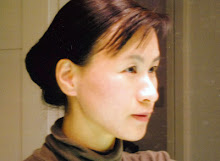
Part of a female cuckoo (Cuculus canorus) dissected to show the developing egg, prepared by Edward Jenner (1749-1823) and presented to John Hunter, 1788.
A post card I bought at Hunterian Museum
Copyright 2005 Hunterian Museum at The Royal College of Surgeons
I visited Hunterian Museum at The Royal College of Surgeons tree times (may be more). I always feel down for next one or two days every time after I visit this space. While I understand these dissected collections contributed a lot for today's advanced medical technology, it is very hard for me to avoid imagine their final scream. The enormous Hunterian collection look rather cruel to me but I have to say some of the specimens in glass cylinders are just look stunning. –This place easily makes me believe I tend to appreciate beauties more than ethics and it always annoys me.

However, I have to treat this very carefully. Why the female cuckoo in a glass cylinder looked so sad and beautiful? Instead of trying to get plausible reasoning, I made 9 sketches of another cuckoo specimen from the same angle. The sketch could be more but I stopped when I found essential lines of painful distortion in the 9th sketch. What I have seen in the glass cylinder is an evidence of her life. Though no one can help her anymore, I thought I can paint about her at least.

